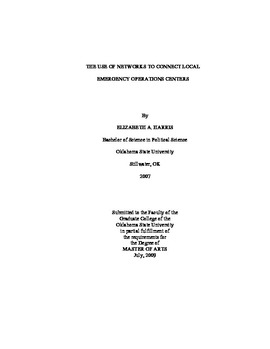| dc.contributor.advisor | Phillips, Brenda | |
| dc.contributor.author | Harris, Elizabeth A. | |
| dc.date.accessioned | 2014-04-15T22:32:45Z | |
| dc.date.available | 2014-04-15T22:32:45Z | |
| dc.date.issued | 2009-07-01 | |
| dc.identifier.uri | https://hdl.handle.net/11244/9607 | |
| dc.description.abstract | This study seeks to discover how local emergency operations centers in one community connect to provide a coordinated multijurisdictional response. The study is based on a qualitative research design. In order to gain data for analysis, the researcher employed interviews, visual evidence, and documents. The data analysis consisted of three phases. The first phase compared the studied EOCs to the existing literature to determine if they included structures to meet the six general task areas of EOCs as described by Quarantelli (1972; 1978). The second phase compared the statements of each official about their interorganizational relationship to the results of Drabek (1987). The final phase of analysis employed grounded theory to discover the conditions that enabled the EOCs to build and maintain their relationship. Overall the research found that the two EOCs did include structures or operations that would meet the six general task areas of an EOC, which suggests that the EOCs would be effective during an event. The research also found that the two EOCs had formed an integrated interorganizational network, which would suggest that the two EOCs would provide a well-coordinated response during a multijurisdictional event. In addition, the information was analyzed using grounded theory. From this analysis emerged five themes that seem to build and maintain the integrated interorganizational network between the city and university. The five factors are making emergency management a priority, the importance of previous relationships, the importance of overlapping memberships, the use of WebEOC, and formalizing the relationship through mutual aid agreements. The study concluded that the two EOCs studied formed an integrated interorganizational network in order to provide a well-coordinated multijurisdictional response. | |
| dc.format | application/pdf | |
| dc.language | en_US | |
| dc.publisher | Oklahoma State University | |
| dc.rights | Copyright is held by the author who has granted the Oklahoma State University Library the non-exclusive right to share this material in its institutional repository. Contact Digital Library Services at lib-dls@okstate.edu or 405-744-9161 for the permission policy on the use, reproduction or distribution of this material. | |
| dc.title | Use of networks to connect local emergency operations centers | |
| dc.type | text | |
| dc.contributor.committeeMember | Neal, David | |
| dc.contributor.committeeMember | Brown, Anthony | |
| osu.filename | Harris_okstate_0664M_10409.pdf | |
| osu.college | Arts and Sciences | |
| osu.accesstype | Open Access | |
| dc.description.department | Political Science | |
| dc.type.genre | Thesis | |
| dc.subject.keywords | emergency operations centers | |
| dc.subject.keywords | networks | |
